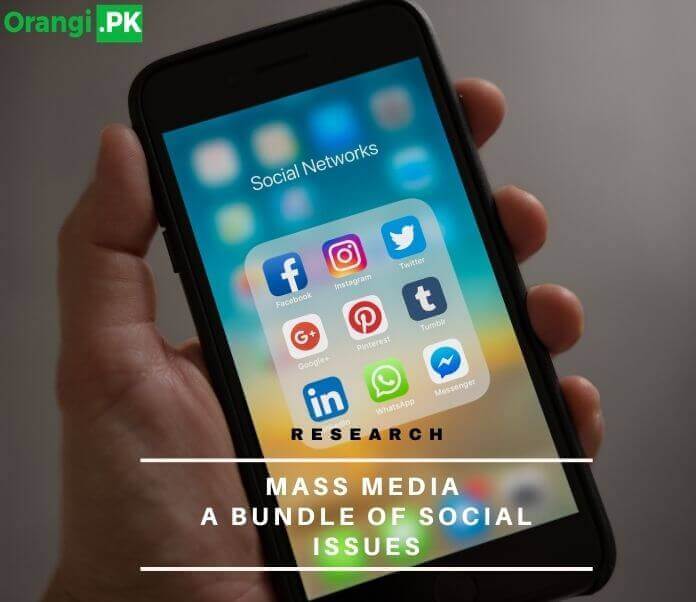This article is presented by Sandra Nicole expressing her views over the alarming issue of Mass Media in Pakistan. The motive of writing over this issue is to highlight the important factors of mass media across the country.
Mass media refers to a diverse set of media technologies that reach a significant audience through mass communication. New media technology has a substantial impact on contemporary society, and at the end of 2008, 60% of the world’s population used mobile phones.
While the importance of these devices and the Internet is unprecedented in many ways, it is not entirely reliable. It is essentially a pack of social issues.
Transnational companies like Google and Microsoft, control Internet technology, represents a threat to democracy because the power of the already powerful is strengthening. More than we know is dominated and controlled by these companies.
False reports and the proliferation of information cocoons can increase fragmentation, polarization, and extremism. If one lives in an information cocoon, they will believe in many unreal things and will fail to learn countless things that are true. These false rumors can be detrimental to the government or other organizations. For instance, in the current events of the coronavirus pandemic, fake ‘desitotkas’ were being pooled on social media (typically Whatsapp).
While it may be argued that media offers the generalized opinion of the majority, it may well be the case that those opinions are of what belongs to the producers and writers.
Advertising is that of more or less the same content on different television channels and does not attract an audience. Instead, the combination of information and entertainment (infotainment) and exploitation of public matters replace serious programming. For example, in the recent events of Aurat March in Pakistan, women stepped forward for their rights. Some people in the society took these issues non-seriously to the extent of jokingly dragging them in various memes.
While the media have made long-distance communications much accessible than before, they may increase the risk of social isolation in the future. Spend much time on social platforms instead of spending quality time socializing with family and friends.
People are driven towards faking their social lives, just to live up to the standards of others. This may lead to depression.
People can become imposters and fraudsters, claiming themselves as someone that they are not.
Another disadvantage of the media is that some of the content you see is not suitable for children. It is difficult for parents who are not always at home or who allow others to care for their children. Some steps have been taken to restrict children’s access to this adult content, but these restrictions can sometimes be violated because children seem to know more tips than their parents.
It can lead to a digital divide, as not everyone can afford or have the technology to access new media. It creates global and national inequalities. For example, Netflix requires its users to pay a certain amount per month, and people who cannot afford it will feel left out. People are now investing more and more in these products just to get socially accepted. While inequality in the world in terms of race, religion, and nationality are discussed, disparities in digital media are emerging as one of the main problems facing the world.
On one side, where the media can help retain private information safe, it can also, on the other hand, include a risk of hackers inaccurately getting access to one’s data.
Using electronic devices such as mobile phones and computers for a long time continuously can affect an individual’s health; namely deteriorated eyesight, obesity, and muscle and joint problems.
The media also play a significant role in the formation of impressions and prejudices about different social groups. It often exaggerates some characteristics of certain people in a group and assumes that all members of that community or race are the same. For example, people all over the world think that Asians are better at doing Math’s than anyone else around the world.
These stereotypes extend to expectations of gender roles. These are conceptions about what men and women are, and many people around the world agree with that. Girls and women are expected to display the feminine characteristics of being beautiful, slim, gentle, loving, sensitive, submissive, uncompetitive, and dependent. Male stereotypes highlight traits such as physical strength, aggressiveness, independence, ambition, and success at work. These qualities represented in media leads to unrealistic expectations.
The stereotype of ethnic minority groups is portrayed in films and other media contexts, using them as scapegoats for significant conflicts and problems in the country that would not otherwise exist. For example criminals, such as drug traffickers and “aggressors” (who commit violent street robberies). These minority groups are responsible for creating a sense of unity in society, uniting the public against a common enemy.
Young people are relatively powerless and constitute an easily identifiable group to blame for all the ills of society. Some youth who engage in illegal and antisocial behavior, such as vandalism and the use of soft drugs, are qualified.
The media is a two-edged sword. It can be as detrimental as beneficial. Eliminating it as a solution to the social issues that arise because of it, is not exactly an answer either. It instead entirely depends on an individual’s use of it.







